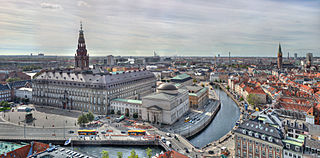
Copenhagen is the capital and most populous city of Denmark, with a population of 1.4 million in the urban area. The city is situated on the islands of Zealand and Amager, separated from Malmö, Sweden, by the Øresund strait. The Øresund Bridge connects the two cities by rail and road.

Tivoli Gardens, also known simply as Tivoli, is an amusement park and pleasure garden in Copenhagen, Denmark. The park opened on 15 August 1843 and is the third-oldest operating amusement park in the world, after Dyrehavsbakken in nearby Klampenborg, also in Denmark, and Wurstelprater in Vienna, Austria.

Dirch Hartvig Passer was a Danish actor and comedian. He was greatly renowned for his improvisational skills and, with a filmography comprising 90 films, one of Denmark's most prolific actors. His life is depicted in the Danish semi-biographical film A Funny Man directed by Martin Zandvliet and starring Nikolaj Lie Kaas as Dirch Passer.
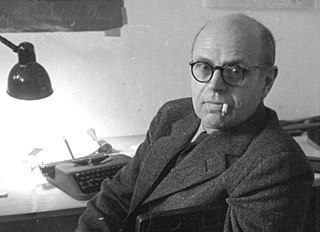
Poul Henningsen was a Danish author, critic, architect, and designer. In Denmark, where he often is referred to simply as PH, he was one of the leading figures of the cultural life of Denmark between the World Wars.

Johan Bernhard Georg Carstensen was a Danish army officer and one of the developers of Tivoli Gardens. He spent most of his childhood in the Near East. He travelled widely and had a career in the military Royal Guards, reaching the rank of lieutenant. He attended boarding school at Herlufsholm kostskole.
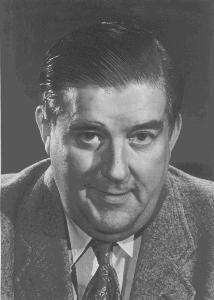
Ib Christian Albert von Cotta Schønberg was a Danish film actor, and is considered one of the leading actors of Danish film in the 20th century.

Copenhagen Castle was a castle on the islet of Slotsholmen in central Copenhagen, Denmark. It was built in the late 14th century and was located at the site of the current Christiansborg Palace.
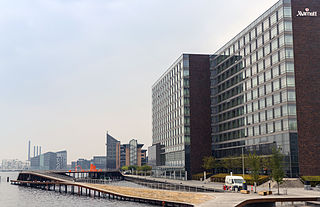
Kalvebod Brygge is a waterfront area in the Vesterbro district of Copenhagen, Denmark. The name also refers to a section of the Ring 2 ring road which follows the waterfront from Langebro in the north to the H. C. Ørsted Power Station in the south. The area is dominated by office buildings, Tivoli Conference Center, several hotels and the shopping centre Fisketorvet.

Frederiksberg Allé is a tree-lined avenue which runs through the southernmost part of the Frederiksberg district of Copenhagen, Denmark. It connects Vesterbrogade at Værnedamsvej to Frederiksberg Runddel in front of the main entrance to Frederiksberg Gardens. It was originally constructed in 1704 as the king's private road leading to his new summer residence, Frederiksberg Palace. It developed into the backbone of an entertainment district in the mid 18th century, and has continued to be associated with theatres until the present day. The avenue is lined with two double rows of linden trees and bisects Sankt Thomas Plads, a small round plaza, shortly after its departure from Vesterbrogade.
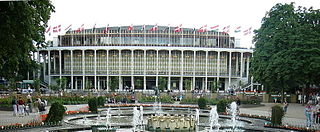
Tivoli Concert Hall is a 1,660-capacity concert hall at Tivoli Gardens in Copenhagen, Denmark. The building, which was designed by Frits Schlegel and Hans Hansen, was built between 1954 and 1956. The concert hall is used for classical music, Broadway musicals, and jazz musicians.

Åboulevard is a street in central Copenhagen, Denmark. Together with H. C. Andersens Boulevard in the city centre and Borups Allé, it forms a major artery in and out of the city. The road is built over Ladegårds Å, a canal originally built to supply Copenhagen with water, which still runs in a pipe under it, feeding water into Peblinge Lake.
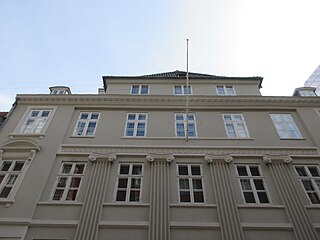
The Waagepetersen House is a listed Neoclassical town mansion located at Store Strandstræde 18 in Copenhagen, Denmark. The house takes its name after royal wine merchant Christian Waagepetersen who owned it from 1811 to 1840. His home was a meeting place for many of the leading figures of the Danish Golden Age.

The Niels Aagesen House is a property at Amaliegade 22 in the Frederiksstaden district of central Copenhagen, Denmark. It was listed on the Danish register of protected buildings and places in 1945. A plaque on the facade commemorates that the poet Adam Oehlenschläger died in the building on 20 November 1840. Other notable former residents include the naval officer Steen Andersen Bille, Tivoli Gardens-founder Georg Carstensen, medical doctor Ole Bang, diplomat and minister H. E. Reedtz (1800-1857), politician Christian Albrecht Bluhme (1794-1866), General Christian de Meza (1792-1865) and politician Aleth Hansen.
Alhambravej is a street in the Frederiksberg district of Copenhagen, Denmark. It runs from Frederiksberg Allé in the south to Gammel Kongevej in the north, linking Kingogade with H. C. Ørstedsvej. The street takes its name after Alhambra, a now demolished 19th-century entertainment complex which was located on its east side.

Tietgensgade is a street in central Copenhagen, Denmark. It runs from H. C. Andersens Boulevard in the northeast to Kvægtorvgade at the Meat-Packing District in the southwest, linking Stormgade in the city centre with Ingerslevsgade and Halmtorvet/Sønder Boulevard in Vesterbro. The street follows the rear side of Tivoli Gardens and Copenhagen Central Station. The viaduct that carries it across the railway tracks at the central station is known as Tietgensbro. A series of staircases and lifts provides direct access from the viaduct to the station platforms.

The March Revolution in Denmark are the events of 1848 that ultimately led to the introduction of Danish constitutional monarchy and the Constitution of Denmark.
Henrik Larsen Kyhl was a Danish clockmaker, politician and the second managing director of Tivoli Gardens in Copenhagen.

Gammel Strand 40 is a Neoclassical property overlooking Slotsholmen Canal in the Olt Town of Copenhagen, Denmark. The building was listed in the Danish registry of protected buildings and places in 1945. A commemorative plaque above the doorway commemorates that Georg Carstensen, founder of Tivoli Gardens, was a resident in the building when his amusement park opened in 1843. Other notable former residents of Gammel Strand 40 include the archeologist Peter Oluf Brøndsted, writer and editor Jacob Davidsen (1813–1891), songwriter Peter Faber, politician and bishop Ditlev Gothard Monra and journalist Henrik Cacling.d

Rosenborggade 7–9 is a complex of mid-19th-century buildings situated at the corner of Rosenborggade and Tornebuskegade, close to Nørreport station, in the Old Town of Copenhagen, Denmark. It consists of a large corner building, an adjacent building in Rosenborggade and a warehouse in the courtyard. The entire complex was listed in the Danish registry of protected buildings and places in 1975. A plaque on the facade of No. 7 commemorates that the philosopher Søren Kierkegaard resided in the building from 1848 to 1850 and that he wrote The Sickness unto Death and Practice in Christianity while he lived there. Other notable former residents include the actors Ludvig and Louise Phister who lived in the apartment on the second floor of No. 7 from 1859 until their deaths in 1896 and 1916.

Nyhavn 6 is a Neoclassical building situated on the quiet southern side of the Nyhavn canal in central Copenhagen, Denmark. It was listed in the Danish registry of protected buildings and places in 1950. Composer Carl Nielsen and sculptor Anne Marie Carl-Nielsen had their first home together in the garret in the 1890s.





















